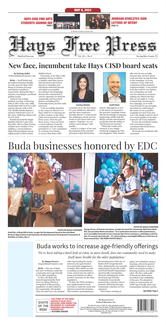After almost three decades of frontier crime fighting, Capt. John Reynolds Hughes retired from the Texas Rangers on Jan. 31, 1915.
As a headstrong youth of 14, Hughes ran away from his Kansas home in 1869 and finished growing up in the Indian Territory. During his six years among the Choctaw, Osage and Comanche, he suffered a wound that partially paralyzed his right arm. He compensated for the disability by learning how to shoot with his left hand.
Hughes herded cattle on the Chisholm Trail until ...
After almost three decades of frontier crime fighting, Capt. John Reynolds Hughes retired from the Texas Rangers on Jan. 31, 1915.
As a headstrong youth of 14, Hughes ran away from his Kansas home in 1869 and finished growing up in the Indian Territory. During his six years among the Choctaw, Osage and Comanche, he suffered a wound that partially paralyzed his right arm. He compensated for the disability by learning how to shoot with his left hand.
Hughes herded cattle on the Chisholm Trail until he saved enough for the down payment on a small spread outside Austin. In the summer of 1885, he took off after a gang of rustlers that had been stealing horses from ranches in the area, including his own. Catching up with the crooks in New Mexico, he singlehandedly slew several of the surprised thieves and handed the survivors over to the nearest sheriff.
During Capt. John Hughes’ six years among the Choctaw, Osage and Comanche, he suffered a wound that partially paralyzed his right arm. He compensatted for the disability by learning how to shoot with his left hand.
When word of the daring deed reached Texas Ranger headquarters, a recruiter was sent to sign up the remarkable rancher. At first Hughes declined the invitation countless Texans would have given their eye teeth for, but eventually agreed to enlist. He pinned on the ringed star, unpretentious symbol of the Lone Star guardians, on Aug. 10, 1887.
Assigned to Company D of the Frontier Battalion, Private Hughes primarily patrolled the lawless no-man’s-land along the border with Mexico. He relished the exciting challenge of the life-or-death existence and decided to make the Rangers his career.
In September 1888, not long after his promotion to captain, Hughes received a tip about an imminent train robbery. According to the source, a gang of notorious outlaws was plotting the crime at their stronghold high in the Davis Mountains.
Always ready to move at a moment’s notice, Hughes and two subordinates — Thalis T. Cook and R.E. Bryant — boarded a train at El Paso with three horses and a pack mule. The next morning in Alpine, they met up with the Presidio County deputy sheriff and a group of volunteers. With an expert tracker leading the way, the posse started their mountain manhunt.
“Nerve without judgment is dangerous and has no place in the Ranger service” was Hughes’ motto. More than a slogan used to weed out reckless applicants, the saying was literally the words he lived by.
Miles from their lofty objective, Hughes instructed his men to remove their badges and to disguise themselves as ordinary cowboys to avoid detection. Accompanied by real ranch hands, Cook rode ahead for a closer look.
The Ranger and his civilian companions wandered into a canyon and the waiting rifles of two bandit sentries. The cowpunchers instantly lost interest in playing lawman and fled the scene leaving Cook to his fate.
Cut from the same cloth as his superior, he kept his head. Cook escaped the ambush unscathed and reported back to Hughes, who led the subsequent attack.
“We ran our horses almost to the top of the mountain,” he wrote in his official account of the skirmish, “when the fight was so hot that we dismounted. We drove them off the mountaintop to the side where two of them were killed.”
In the historic 1900 reorganization of the Rangers, the famous Frontier Battalion was replaced by four companies of 20 troopers each. The quartet of legendary captains put in charge of the new units featured, of course, the highly regarded Hughes.
Forced into retirement 15 years later by a gubernatorial purge, the frugal Ranger did not have to worry where his next meal was coming from. From his earliest days as an underpaid private, Hughes had regularly invested a large chunk of his modest income. As a result, he was able to say with obvious satisfaction, “Jim Ferguson turned me out to starve, but I didn’t starve.”
The fact that Hughes’ 27 years of continuous service was the longest in the history of the Texas Rangers testified to the rapid turnover in the khaki ranks. Many perished in the line of duty, while others opted for less hazardous employment.
Hughes’ twilight years were active and exceptionally prosperous. When not tending to his business holdings, such as the controlling interest in an Austin bank, the well-to-do bachelor did as he pleased taking frequent automobile trips and prospecting for fun and occasional profit.
The old Ranger also became quite the celebrity, especially after he inspired the Zane Grey western novel The Lone Star Ranger, a couple of biographies and a prominent part in W.W. Sterling’s Trails and Trials of a Texas Ranger. He also received the first Certificate of Valor, a national commendation for bravery awarded annually to peace officers.
Until John Reynolds Hughes, depressed and in failing health, took his own life in 1947 at the age of 92, he was the greatly admired real-life symbol of that rugged breed who tamed the Lone Star frontier.
Need a speaker with a Texas twist? There’s none better than Bartee Haile! Contact him at barteehaile.com for more information.







